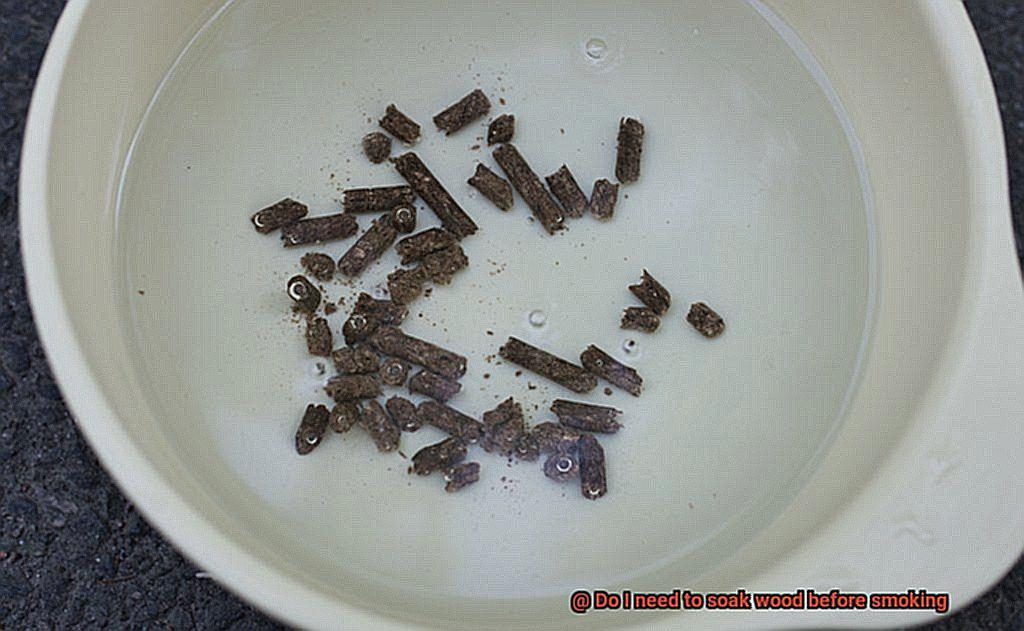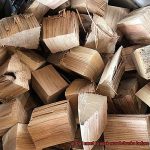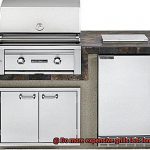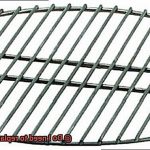Get ready to uncover the smokin’ truth behind a heated debate that’s been grilling minds for ages: should you soak wood before smoking, or is it just a bunch of hickory-smoked hogwash?
Imagine this scene: a balmy summer evening, the air filled with mouthwatering scents of perfectly seasoned meat. Your grill or smoker is fired up, and now comes the pivotal moment – to soak or not to soak.
Here’s the lowdown. Soaking wood before smoking has long been a tradition among pitmasters in the know, with some swearing by its magical powers. But hold your tongs, because skeptics argue that this technique does more harm than good. In this blog post, we’re gonna dig deep into the pros and cons to help you make an informed choice.
Join us as we unravel the mystery behind soaking wood before smoking. We’ll separate fact from fiction and explore all the potential advantages and disadvantages. By the time we’re done, you’ll be armed with knowledge to take your grilling game to new smoky heights – rivaling even those legendary pitmasters.
So grab yourself a cold one, throw on that trusty apron, and let’s dive headfirst into this sizzling debate. Because guess what? The secret to creating smoke-infused feasts like never before is just a few scrolls away.
Contents
Pros of Soaking Wood Before Smoking
It offers several advantages that can enhance the smoking experience and result in deliciously flavored food. Here are the pros of soaking wood before smoking:
Firstly, soaking wood prolongs burn time. By immersing wood chips or chunks in water, the ignition and burning process is slowed down. The wet wood takes longer to ignite and burn compared to dry wood, ensuring a steady and consistent release of smoke throughout the cooking process. This is particularly beneficial for slow-cooking methods like smoking.
Secondly, soaking wood regulates temperature. As the water in soaked wood evaporates during cooking, it creates a moist environment that helps maintain a lower and more stable cooking temperature. This is especially important when smoking delicate meats like fish or poultry, as it prevents them from drying out too quickly.
Thirdly, soaking wood enhances flavor. Soaking allows the wood to absorb moisture, which then vaporizes and carries flavor compounds from the wood into the smoke. This results in a more pronounced and complex smoky flavor in the food being cooked.
Furthermore, soaking wood reduces smoke intensity. Dry wood burns faster and produces more smoke, which can sometimes lead to an overpowering smoky flavor that masks the taste of the food. Soaking the wood helps control the intensity of the smoke, allowing for a more balanced flavor.
Additionally, soaking wood prevents flare-ups and excessive charring. The moisture in soaked wood creates a barrier between the fire and the food, reducing the risk of flare-ups and ensuring even cooking without excessive charring or burning.
Lastly, soaking wood maximizes the use of limited space. For those using charcoal or gas grills with built-in smoker boxes that have limited space for adding wood chips or chunks, soaking the wood maximizes their burn time and smoke production.
Cons of Soaking Wood Before Smoking
Soaking wood before smoking may seem like a magical technique with its benefits, but it’s important to consider the cons as well. Here are some drawbacks to keep in mind before you decide to soak your wood:
- Prolonged preheating time: Soaking wood adds moisture to it, and wet wood takes longer to ignite and reach the desired smoking temperature. This can be frustrating for those who want a quick and efficient smoking process, as it can significantly prolong the preheating time of the smoker or grill.
- Altered smoke flavor: When wood is soaked, it absorbs water, diluting the natural oils and compounds responsible for producing the distinct flavors when it burns. This can result in a milder and less intense smoke flavor. While some people may prefer a milder flavor, others may find it less desirable and miss out on the rich, robust smoky taste they were hoping for.
- Increased steam production: Soaked wood tends to produce more steam than smoke. The moisture in the wood evaporates during the smoking process, creating steam that can interfere with the formation of a proper smoke ring and bark on the meat. This can affect the appearance and texture of the final product, potentially leading to less desirable results.
- Inconsistent burning: The moisture content in soaked wood can vary, causing the wood to burn unevenly and produce fluctuating temperatures in the smoker or grill. This makes it challenging to maintain a steady smoking temperature and achieve consistent results. For those who value precision and control over their smoking process, this inconsistency can be a significant drawback.
- Time-consuming: Depending on the type and size of wood, soaking may require several hours or even overnight to ensure proper moisture absorption. This extra step adds to the overall preparation time, which may not be convenient for those looking for a quick and hassle-free smoking experience.
Different Types of Woods and Flavors
When it comes to smoking food, the type of wood you use can make a big difference in the flavor of the final dish. Each type of wood has its own unique aroma and taste, which can enhance the overall eating experience. Let’s explore some popular types of woods used for smoking and the flavors they impart.
Hickory Wood:
Hickory wood is known for its strong and smoky flavor. It is a popular choice for smoking meats like ribs and bacon, as it adds a rich and savory taste. The bold flavor of hickory pairs well with red meats, giving them a delicious depth of flavor. When using hickory, you can expect your smoked dishes to have a robust and hearty essence that will leave your taste buds craving more.
Mesquite Wood:
Mesquite wood provides a robust and earthy flavor to smoked foods. It works particularly well with beef and poultry, adding a bold and slightly sweet taste. Mesquite is often used in southwestern cuisine, as it complements the flavors of spices and marinades. When smoking with mesquite wood, you can expect your dishes to have a distinctive smoky aroma that will transport you to the heart of Texas.
Apple Wood:
If you prefer a milder and sweeter flavor, apple wood is a great choice. It adds a delicate fruity essence to any dish, making it ideal for smoking poultry and pork. The subtle sweetness of apple wood enhances the natural flavors of the meat without overpowering them. When using apple wood, you can expect your smoked dishes to have a hint of fruity sweetness that will leave you wanting more.
Cherry Wood:
Cherry wood adds a slightly fruity and sweet taste to smoked foods. It is a versatile wood that pairs well with pork and game meats. The mild flavor of cherry wood allows the meat to shine while providing a hint of sweetness that elevates the overall taste. When using cherry wood, you can expect your smoked dishes to have a touch of fruity elegance that will impress your guests.
Oak Wood:
Oak wood offers a medium-strong flavor that complements almost any type of meat. Its versatility makes it a popular choice among pitmasters. Oak provides a balanced smoky taste that enhances the natural flavors of the meat without overpowering them. When using oak wood, you can expect your smoked dishes to have a classic and timeless smoky flavor that will satisfy even the most discerning palates.
Factors to Consider When Deciding Whether to Soak Wood or Not
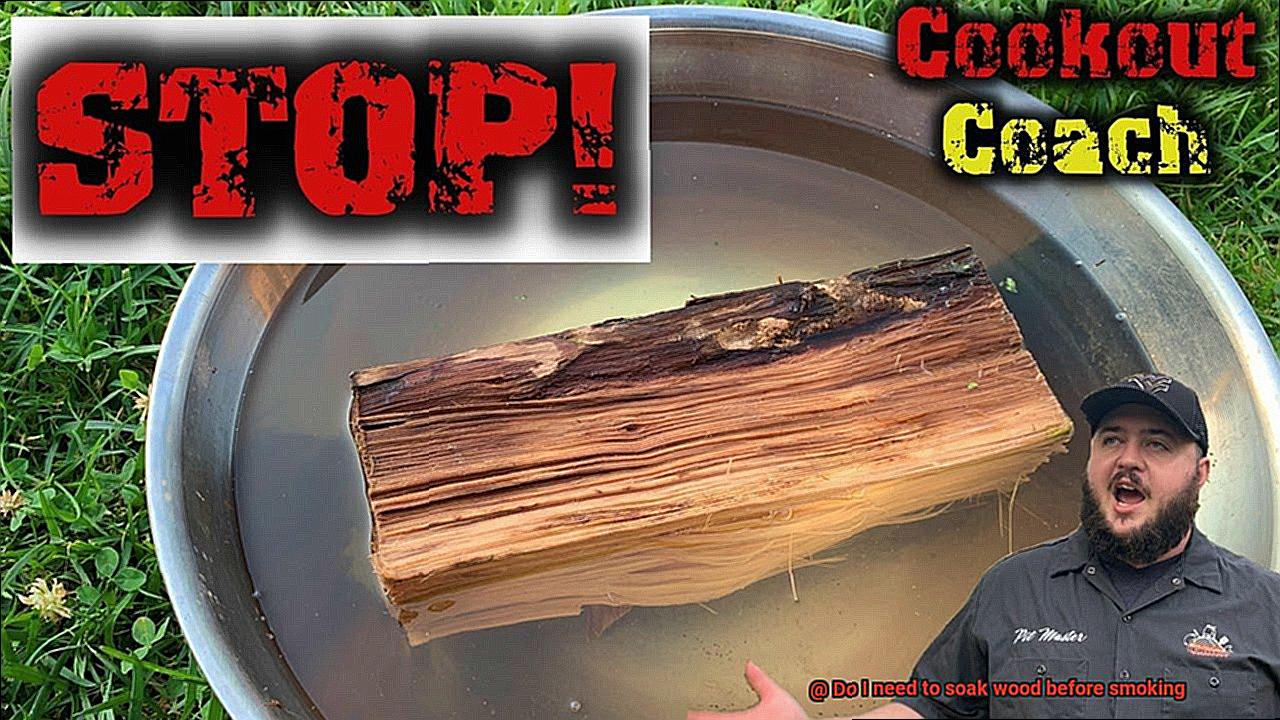
When it comes to grilling and smoking food with wood, the decision of whether or not to soak the wood is a question that often arises. To help you make an informed decision, there are several factors to consider.
Firstly, the type of wood plays a crucial role. Different types of wood have varying levels of moisture content. Soaking hardwoods like oak, hickory, and maple can help increase their moisture content and prevent them from burning too quickly during the smoking process.
The smoking method you plan to use is another important factor. If you’re using a direct heat method like grilling, soaking the wood can prevent it from catching fire and producing excessive smoke. On the other hand, if you’re using an indirect heat method like smoking in a smoker, soaking the wood may not be necessary as the heat is controlled.
The desired smoke flavor also comes into play. Soaking wood can impact the flavor profile of the smoke. If you prefer a milder smoke flavor, soaking the wood can produce a smoother and subtler taste. However, if you enjoy a more intense and robust smoke flavor, using dry wood may be preferable as it releases more potent aromas.
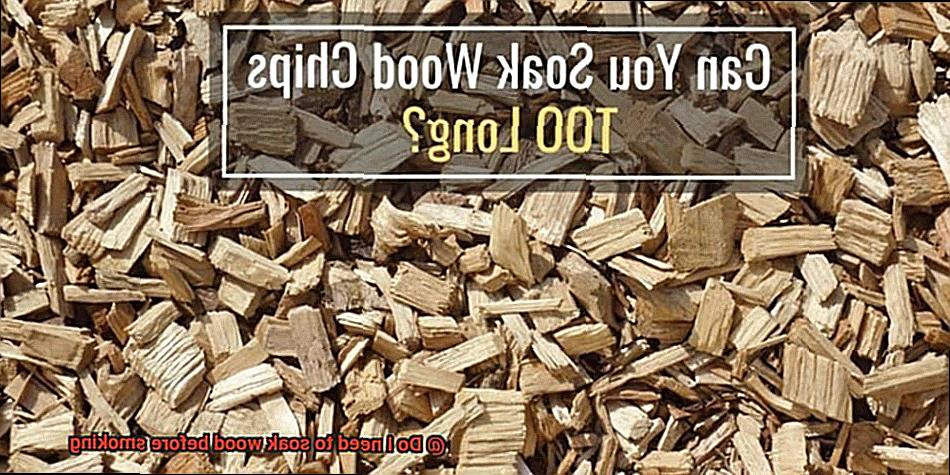
Cooking time is another consideration. Soaked wood tends to burn slower than dry wood, which can be beneficial for longer cooking times. If you’re planning on slow-cooking your meat or smoking it for several hours, soaked wood can provide a consistent source of smoke throughout the process.
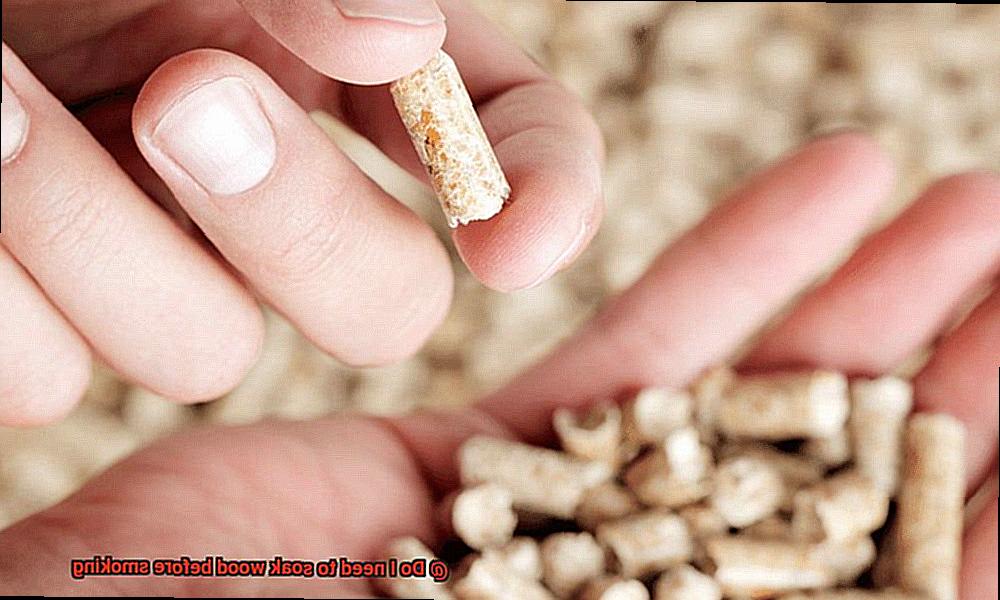
Ultimately, personal preference plays a significant role in deciding whether to soak wood or not. Some people swear by soaking as it helps control the intensity of smoke and prevents flare-ups. Others prefer using dry wood for a stronger smoky flavor and faster cooking times. Experimenting with both methods can help you determine your preferred approach.
Guidelines for Soaking Wood Before Smoking
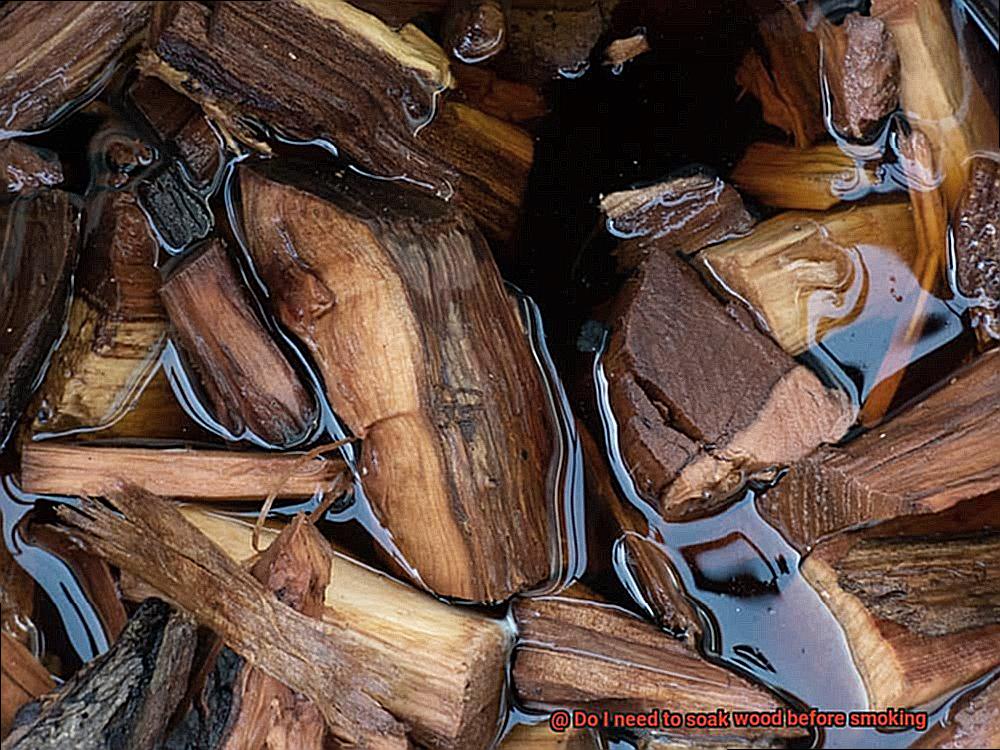
When it comes to soaking wood before smoking, there are several important guidelines to keep in mind. These guidelines will help ensure that you have the best BBQ experience possible. Let’s take a closer look at what you need to know:
- Consider the type of wood you’re using: Different types of wood have different characteristics that can affect the smoking process. Hardwoods like oak, hickory, and mesquite are denser and burn slower, so they may not require soaking. On the other hand, softer woods like cedar and fruit trees tend to burn faster and benefit from soaking to prolong their burn time.
- Use clean water: It’s essential to use clean, filtered water when soaking your wood. This helps avoid any impurities or contaminants that could affect the flavor of the smoke. Fill a container with enough water to fully submerge the wood.
- Soaking time: The length of time you should soak your wood depends on its thickness and moisture content. As a general guideline, soak the wood for at least 30 minutes, but it may need several hours for thicker pieces. Some experts even recommend adding weight on top of the wood to ensure it remains fully submerged.
- Avoid over-soaking: Be careful not to over-soak your wood. Over-soaked wood can produce steam instead of smoke, which can result in a less desirable flavor profile. Additionally, excessively wet wood can lower the cooking temperature and increase cooking time.
- Consider pre-packaged options: If you prefer convenience or consistency, consider using pre-packaged wood chunks or chips that are specifically designed for smoking. These products are typically kiln-dried, which reduces their moisture content and eliminates the need for soaking.
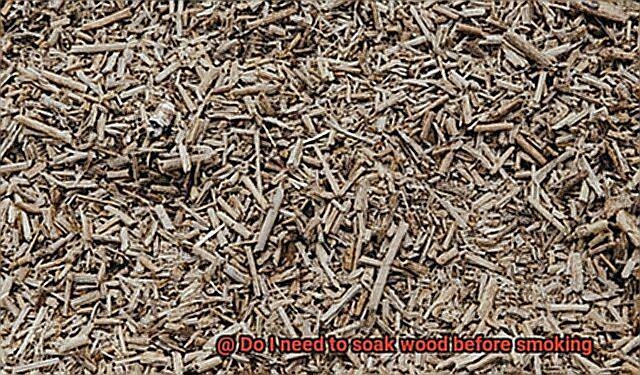
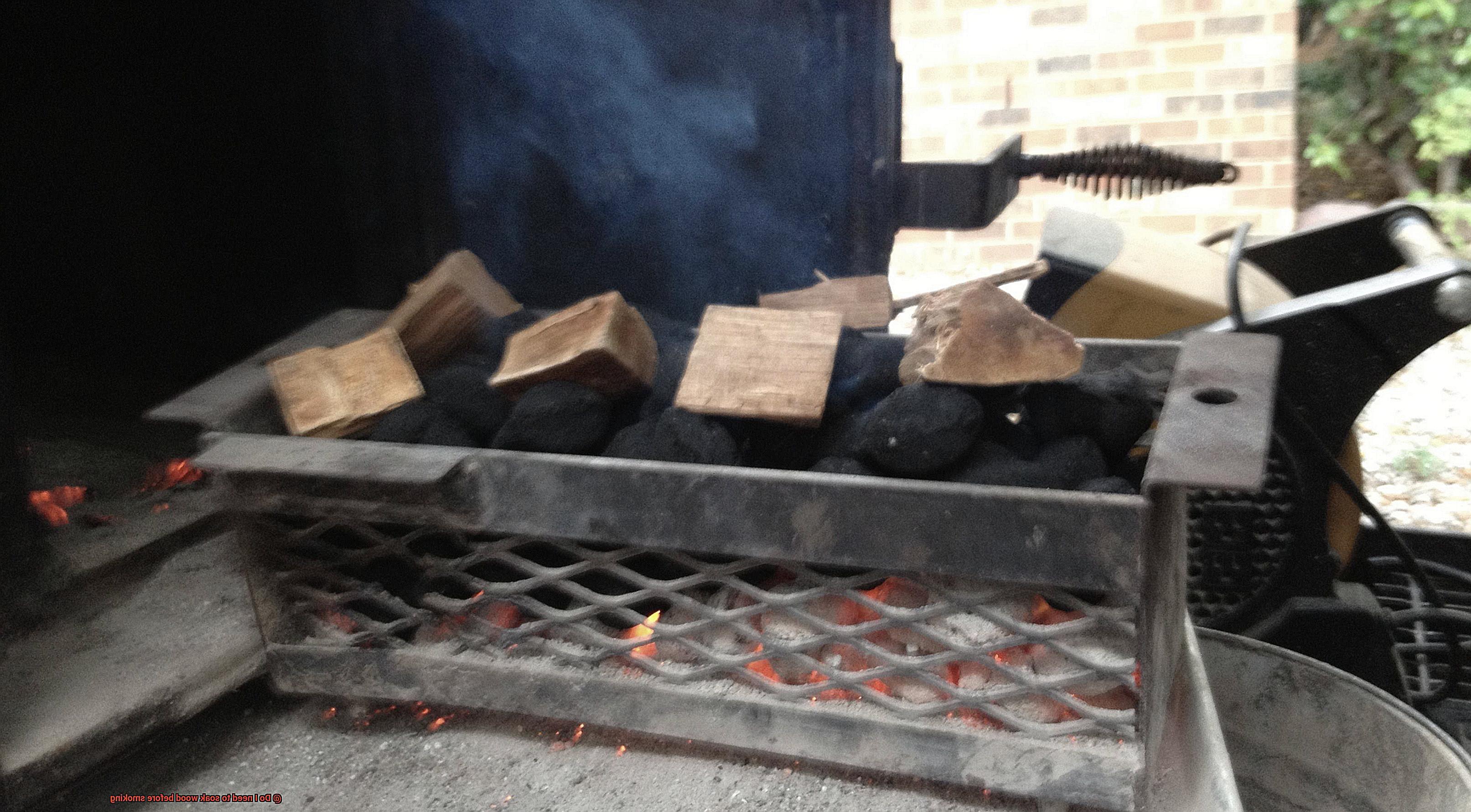
Remember, the decision to soak or not to soak ultimately depends on your personal preference and the specific circumstances of each grilling session. Beginners can experiment with both soaked and dry wood to understand the differences in flavor profiles and smoke intensity. Experienced grillers often develop their own techniques based on factors like wood type, desired smoke flavor, and cooking duration.
Benefits of Experimenting with Both Wet and Dry Woods
When it comes to smoking food, the benefits of experimenting with both wet and dry woods are plentiful. Let’s delve into the advantages that arise from using both types of woods:
- Flavors and aromas: One of the greatest benefits of using both wet and dry woods is the wide range of flavors and aromas they offer to your smoked dishes. Wet wood tends to produce copious amounts of smoke, resulting in a robust and intense smoky flavor. On the other hand, dry wood imparts a milder smoke flavor. By experimenting with different woods, you can tailor the taste of your smoked dishes to your personal preference.
- Smoking duration: Soaking wood before smoking can significantly extend the smoking process. Wet wood takes longer to burn compared to dry wood, facilitating a slower cooking process. This proves especially advantageous when smoking larger cuts of meat that require more time in the smoker, ensuring that they are thoroughly cooked and infused with smoky goodness.
- Temperature control: Wet wood serves as a valuable tool for maintaining a steady temperature inside the smoker. Consistency is key when it comes to achieving even cooking throughout your food. The moisture in wet wood acts as a buffer against temperature fluctuations, guaranteeing consistent results and preventing any unwanted variations.
- Burn rate: Dry wood, in contrast to its wet counterpart, burns faster and hotter. This makes it perfect for shorter smoking sessions or when you desire higher temperatures in your smoker. Dry wood provides an intense burst of smoke flavor in a shorter amount of time, ideal for infusing smoky goodness into any dish.
- Personal preference and dish selection: The choice between wet and dry wood ultimately hinges on personal preference and the specific dish being smoked. Some experts recommend soaking certain types of wood, such as fruitwood or lighter woods, while others advocate for using dry wood to achieve stronger flavors like mesquite or hickory. By experimenting with different types of wood and moisture levels, you can find the perfect balance of flavor and aroma that suits your taste buds.
How to Achieve Desired Results without Soaking Wood
Achieving desired results without soaking wood before smoking can be accomplished through various alternative methods. One such method is using dry wood chips or chunks. Dry wood can still produce flavorful smoke without the need for soaking. However, it’s important to note that dry wood burns faster than soaked wood, so it’s necessary to keep a close eye on the smoker and monitor the temperature to prevent the wood from burning too quickly. Using high-quality, properly seasoned dry wood is crucial for the best results. Dry wood can enhance the flavor of the smoked food while saving time and effort.
Another method to achieve desired results without soaking wood is by utilizing wood pellets. Wood pellets are compressed sawdust that has been thoroughly dried. These pellets are designed to produce consistent smoke and can be used without soaking. They are easy to use and provide a convenient alternative to traditional wood chips or chunks. Wood pellets come in various flavors such as apple, hickory, or mesquite, allowing you to add unique aromas and tastes to your smoked food.
Furthermore, using flavored wood chips or chunks can enhance the flavor of the smoke without soaking. Different types of flavored wood such as apple, hickory, or mesquite can add unique aromas and tastes to your smoked food. These chips or chunks can be used directly without soaking, saving time and effort. Experimenting with different flavors can help you find your favorite combination.
Electric smokers are another option that eliminates the need for soaking wood altogether. They use electric heating elements to generate smoke, eliminating the need for traditional wood-burning methods. Electric smokers often come with built-in trays or chambers for adding wood chips or pellets directly. This makes it convenient and efficient to smoke food without the hassle of soaking wood.
While achieving desired results without soaking wood is possible, it’s important to note that there may be some differences in flavor and intensity compared to using soaked wood. Soaked wood tends to produce a milder smoke flavor, while dry wood or pellets may result in a stronger and more concentrated smoke flavor. Experimenting with different methods and types of wood can help you find the perfect balance for your smoking preferences. Try different combinations and adjust the amount of wood used to achieve the desired flavor profile.
APLK-C6kdn0″ >
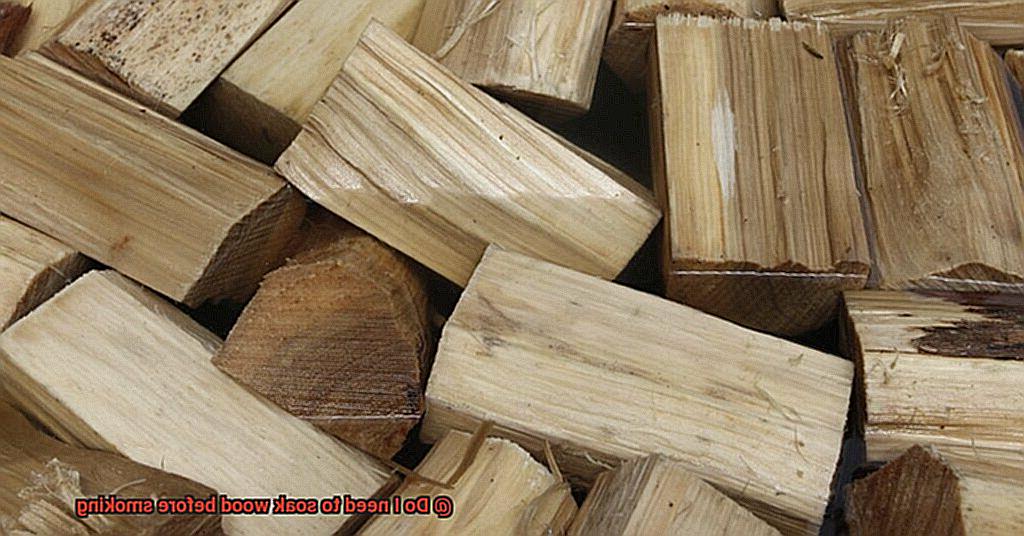
Conclusion
In conclusion, the debate rages on: should you soak wood before smoking? This sizzling topic ignites passion among grill masters and barbecue enthusiasts alike. But at the end of the day, it all boils down to personal preference and the unique circumstances of each grilling session.
Soaking wood before smoking brings a plethora of advantages that elevate the smoking experience and leave your taste buds dancing with delight. It extends burn time, regulates temperature like a maestro, amplifies flavor to mouthwatering levels, tames smoke intensity, prevents fiery flare-ups and excessive charring, and maximizes precious grilling real estate. These benefits have turned soaking wood into a cherished ritual for pitmasters who swear by its enchanting powers.
Yet, there are drawbacks to consider in this smoky equation. Soaking wood can delay preheating time, alter the delicate balance of smoke flavor, unleash steam like a steam engine gone wild, ignite inconsistent burning patterns, and demand an investment of time that not everyone can afford. These factors may not appeal to those seeking swift and efficient smoking or those yearning for an intense smoky punch.
Embrace the adventurous spirit within you by experimenting with both wet and dry woods. Each offers a tantalizing array of flavors and aromas for your smoked creations. Wet wood delivers a robust and unyielding smoky essence that lingers on your palate while providing extended smoking sessions with temperature control fit for a virtuoso. On the other hand, dry wood blazes through its combustion journey faster and hotter—a perfect match for shorter smoking endeavors or when you crave scorching temperatures.
If you opt against soaking your wood, fear not. Alternative methods await your exploration. Dry wood chips or chunks stand ready to lend their flavorful touch to your grilling escapades. Wood pellets offer another avenue to explore in pursuit of smoky perfection. Flavored wood chips or chunks can be used directly without any soaking, while electric smokers eliminate the need for soaking altogether.
Ultimately, the choice to soak wood before smoking rests solely in your hands, guided by your unique taste buds and the specific circumstances of each grilling session. The key lies in embarking on a journey of experimentation, embracing different methods and types of wood to uncover that elusive balance of flavor and aroma that sings to your soul.

